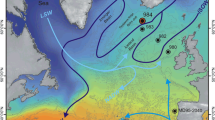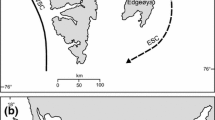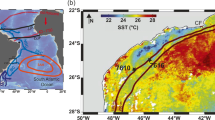Abstract
The Nordic Seas are the primary location where the warm waters of the North Atlantic Current densify to form North Atlantic Deep Water, which plays a key part in the modern Atlantic Meridional Overturning Circulation. The formation of dense water in the Nordic Seas and Arctic Ocean and resulting ocean circulation changes were probably driven by and contributed to the regional and global climate of the last glacial maximum (LGM). Here we map the source and degree of mixing of deep water in the Nordic Seas and through the Arctic Gateway (Yermak Plateau) over the past 35 thousand years using neodymium isotopes (εNd) measured on authigenic phases in deep-sea sediments with a high spatial and temporal resolution. We find that a large-scale reorganization of deep-water formation in the Nordic Seas took place between the LGM (23–18 thousand years ago) and the rapid climate shift that accompanied the subsequent deglaciation (18–10 thousand years ago). We show that homogeneous εNd signatures across a wide range of sites support LGM deep-water formation in the Nordic Seas. In contrast, during the deglaciation, disparate and spatially variable εNd values are observed leading to the conclusion that deep-water formation may have been reduced during this time.




Similar content being viewed by others
Data availability
All data from this study can be found in the supplementary information (data tables) and can be accessed through the PANGAEA data archive.
Code availability
All modelling and statistical analysis was carried out with the use of published open-access software in R, as referenced in Methods. R codes used for the numerical procedures are available from the corresponding author upon reasonable request.
References
Aagaard, K., Swift, J. H. & Carmack, E. C. Thermohaline circulation in the Arctic Mediterranean Seas. J. Geophys. Res. Oceans 90, 4833–4846 (1985).
Hansen, B. & Østerhus, S. North Atlantic–Nordic Seas exchanges. Prog. Oceanogr. 45, 109–208 (2000).
Rahmstorf, S. Ocean circulation and climate during the past 120,000 years. Nature 419, 207–214 (2002).
Howe, J. N. W. et al. North Atlantic deep water production during the last glacial maximum. Nat. Commun. 7, 11765 (2016).
Oppo, D. W. et al. Data constraints on glacial Atlantic water mass geometry and properties. Paleoceanogr. Paleoclimatol. 33, 1013–1034 (2018).
Keigwin, L. D. & Swift, S. A. Carbon isotope evidence for a northern source of deep water in the glacial western North Atlantic. Proc. Natl Acad. Sci. USA 114, 2831–2835 (2017).
Ezat, M. M., Rasmussen, T. L., Skinner, L. C. & Zamelczyk, K. Deep ocean 14C ventilation age reconstructions from the Arctic Mediterranean reassessed. Earth Planet. Sci. Lett. 518, 67–75 (2019).
Veum, T., Jansen, E., Arnold, M., Beyer, I. & Duplessy, J.-C. Water mass exchange between the North Atlantic and the Norwegian Sea during the past 28,000 years. Nature 356, 783–785 (1992).
Bauch, H. A. et al. A multiproxy reconstruction of the evolution of deep and surface waters in the subarctic Nordic seas over the last 30,000 yr. Quat. Sci. Rev. 20, 659–678 (2001).
Hoffmann, S. S., McManus, J. F., Curry, W. B. & Brown-Leger, L. S. Persistent export of 231Pa from the deep central Arctic Ocean over the past 35,000 years. Nature 497, 603–606 (2013).
Thornalley, D. J. R. et al. A warm and poorly ventilated deep Arctic Mediterranean during the last glacial period. Science 349, 706–710 (2015).
Nørgaard-Pedersen, N. et al. Arctic Ocean during the Last Glacial Maximum: Atlantic and polar domains of surface water mass distribution and ice cover. Paleoceanography 18, 1063 (2003).
Ezat, M. M., Rasmussen, T. L. & Groeneveld, J. Persistent intermediate water warming during cold stadials in the southeastern Nordic seas during the past 65 k.y. Geology 42, 663–666 (2014).
Knies, J. et al. Nordic Seas polynyas and their role in preconditioning marine productivity during the Last Glacial Maximum. Nat. Commun. 9, 3959 (2018).
Yu, J., Elderfield, H. & Piotrowski, A. M. Seawater carbonate ion-δ13C systematics and application to glacial–interglacial North Atlantic ocean circulation. Earth Planet. Sci. Lett. 271, 209–220 (2008).
Ezat, M. M. et al. Ventilation history of Nordic Seas overflows during the last (de)glacial period revealed by species-specific benthic foraminiferal 14C dates. Paleoceanography 32, 172–181 (2017).
Cronin, T. M. et al. Deep Arctic Ocean warming during the last glacial cycle. Nat. Geosci. 5, 631–634 (2012).
Ezat, M. M. et al. Deep ocean storage of heat and CO2 in the Fram Strait, Arctic Ocean during the last glacial period. Paleoceanogr. Paleoclimatol. 36, e2021PA004216 (2021).
Rasmussen, T. L. & Thomsen, E. Warm Atlantic surface water inflow to the Nordic Seas 34-10 calibrated ka B.P. Paleoceanography 23, PA1201 (2008).
Altuna, N. E. B., Ezat, M. M., Greaves, M. & Rasmussen, T. L. Millennial-scale changes in bottom water temperature and water mass exchange through the Fram Strait 79° N, 63–13 ka. Paleoceanogr. Paleoclimatol. 36, e2020PA004061 (2021).
Frank, M. Radiogenic isotopes: tracers of past ocean circulation and erosional input. Rev. Geophys. 40, 1–38 (2002).
Struve, T. et al. Ice-sheet driven weathering input and water mass mixing in the Nordic Seas during the last 25,000 years. Earth Planet. Sci. Lett. 514, 108–118 (2019).
Abbott, A. N. A benthic flux from calcareous sediments results in non-conservative neodymium behavior during lateral transport: a study from the Tasman Sea. Geology 47, 363–366 (2019).
Roberts, N. L. & Piotrowski, A. M. Radiogenic Nd isotope labeling of the northern NE Atlantic during MIS 2. Earth Planet. Sci. Lett. 423, 125–133 (2015).
Müller, J. & Stein, R. High-resolution record of late glacial and deglacial sea ice changes in Fram Strait corroborates ice–ocean interactions during abrupt climate shifts. Earth Planet. Sci. Lett. 403, 446–455 (2014).
Chauhan, T., Rasmussen, T. L. & Noormets, R. Palaeoceanography of the Barents Sea continental margin, north of Nordaustlandet, Svalbard, during the last 74 ka. Boreas 45, 76–99 (2016).
Rudels, B. et al. The interaction between waters from the Arctic Ocean and the Nordic Seas north of Fram Strait and along the East Greenland Current: results from the Arctic Ocean-02 Oden expedition. J. Mar. Syst. 55, 1–30 (2005).
Chauhan, T., Noormets, R. & Rasmussen, T. L. Glaciomarine sedimentation and bottom current activity on the north-western and northern continental margins of Svalbard during the late Quaternary. Geo-Mar. Lett. 36, 81–99 (2016).
Laukert, G. et al. Ocean circulation and freshwater pathways in the Arctic Mediterranean based on a combined Nd isotope, REE and oxygen isotope section across Fram Strait. Geochim. Cosmochim. Acta 202, 285–309 (2017).
Andersson, P. S. et al. Neodymium isotopes in seawater from the Barents Sea and Fram Strait Arctic–Atlantic gateways. Geochim. Cosmochim. Acta 72, 2854–2867 (2008).
Lacan, F. & Jeandel, C. Neodymium isotopic composition and rare earth element concentrations in the deep and intermediate Nordic Seas: constraints on the Iceland Scotland Overflow Water signature. Geochem. Geophys. Geosyst. 5, Q11006 (2004).
Telesiński, M. M., Ezat, M. M., Muschitiello, F., Bauch, H. A. & Spielhagen, R. F. Ventilation history of the Nordic Seas deduced from pelagic–benthic radiocarbon age offsets. Geochem. Geophys. Geosyst. 22, e2020GC009132 (2021).
Maccali, J., Hillaire-Marcel, C., Carignan, J. & Reisberg, L. C. Geochemical signatures of sediments documenting Arctic sea-ice and water mass export through Fram Strait since the Last Glacial Maximum. Quat. Sci. Rev. 64, 136–151 (2013).
Vogt-Vincent, N., Lippold, J., Kaboth-Bahr, S. & Blaser, P. Ice-rafted debris as a source of non-conservative behaviour for the εNd palaeotracer: insights from a simple model. Geo-Mar. Lett. 40, 325–340 (2020).
Millo, C., Sarnthein, M., Voelker, A. & Erlenkeuser, H. Variability of the Denmark Strait Overflow during the Last Glacial Maximum. Boreas 35, 50–60 (2006).
Pöppelmeier, F. et al. Influence of ocean circulation and benthic exchange on deep northwest Atlantic Nd isotope records during the past 30,000 years. Geochem. Geophys. Geosyst. 20, 4457–4469 (2019).
Blaser, P. et al. Labrador Sea bottom water provenance and REE exchange during the past 35,000 years. Earth Planet. Sci. Lett. 542, 116299 (2020).
Crocker, A. J. et al. Geochemical response of the mid-depth Northeast Atlantic Ocean to freshwater input during Heinrich events 1 to 4. Quat. Sci. Rev. 151, 236–254 (2016).
Haley, B. A., Frank, M., Spielhagen, R. F. & Eisenhauer, A. Influence of brine formation on Arctic Ocean circulation over the past 15 million years. Nat. Geosci. 1, 68–72 (2008).
Jang, K. et al. Glacial freshwater discharge events recorded by authigenic neodymium isotopes in sediments from the Mendeleev Ridge, western Arctic Ocean. Earth Planet. Sci. Lett. 369–370, 148–157 (2013).
Spielhagen, R. Glaciology: enigmatic Arctic ice sheets. Nature 410, 427–428 (2001).
Clark, P. U. et al. The last glacial maximum. Science 325, 710–714 (2009).
Schlitzer, R. Ocean Data View odv.awi.de (2021).
NGRIP Project Members. High-resolution record of Northern Hemisphere climate extending into the last interglacial period. Nature 431, 147 (2004).
Dubois-Dauphin, Q. et al. Fingerprinting Northeast Atlantic water masses using neodymium isotopes. Geochim. Cosmochim. Acta 210, 267–288 (2017).
Lacan, F. & Jeandel, C. Subpolar mode water formation traced by neodymium isotopic composition. Geophys. Res. Lett. 31, L14306 (2004).
Laukert, G. et al. Transport and transformation of riverine neodymium isotope and rare earth element signatures in high latitude estuaries: a case study from the Laptev Sea. Earth Planet. Sci. Lett. 477, 205–217 (2017).
Werner, K., Frank, M., Teschner, C., Müller, J. & Spielhagen, R. F. Neoglacial change in deep water exchange and increase of sea-ice transport through eastern Fram Strait: evidence from radiogenic isotopes. Quat. Sci. Rev. 92, 190–207 (2014).
Zimmermann, B. et al. Hafnium isotopes in Arctic Ocean water. Geochim. Cosmochim. Acta 73, 3218–3233 (2009).
Porcelli, D. et al. The distribution of neodymium isotopes in Arctic Ocean basins. Geochim. Cosmochim. Acta 73, 2645–2659 (2009).
Blaser, P. et al. Extracting foraminiferal seawater Nd isotope signatures from bulk deep sea sediment by chemical leaching. Chem. Geol. 439, 189–204 (2016).
Wilson, D. J., Piotrowski, A. M., Galy, A. & Clegg, J. A. Reactivity of neodymium carriers in deep sea sediments: implications for boundary exchange and paleoceanography. Geochim. Cosmochim. Acta 109, 197–221 (2013).
Tanaka, T. et al. JNdi-1: a neodymium isotopic reference in consistency with LaJolla neodymium. Chem. Geol. 168, 279–281 (2000).
Jacobsen, S. B. & Wasserburg, G. J. Sm–Nd isotopic evolution of chondrites. Earth Planet. Sci. Lett. 50, 139–155 (1980).
Weis, D. et al. High-precision isotopic characterization of USGS reference materials by TIMS and MC-ICP-MS. Geochem. Geophys. Geosyst. 7, Q08006 (2006).
Hindshaw, R. S., Aciego, S. M., Piotrowski, A. M. & Tipper, E. T. Decoupling of dissolved and bedrock neodymium isotopes during sedimentary cycling. Geochem. Perspect. Lett. https://doi.org/10.7185/geochemlet.1828 (2018).
Blaser, P. et al. The resilience and sensitivity of Northeast Atlantic deep water εNd to overprinting by detrital fluxes over the past 30,000 years. Geochim. Cosmochim. Acta 245, 79–97 (2019).
Sarnthein, M., Balmer, S., Grootes, P. & Mudelsee, M. Planktic and benthic 14C reservoir ages for three ocean basins, calibrated by a suite of 14C plateaus in the glacial-to-deglacial Suigetsu atmospheric 14C record. Radiocarbon 57, 129–151 (2015).
Bronk Ramsey, C. et al. A complete terrestrial radiocarbon record for 11.2 to 52.8 kyr B.P. Science 338, 370–374 (2012).
Heaton, T. J. et al. Marine20—the marine radiocarbon age calibration curve (0–55,000 cal BP). Radiocarbon 62, 779–820 (2020).
Blaauw, M. & Christen, J. A. Flexible paleoclimate age-depth models using an autoregressive gamma process. Bayesian Anal. 6, 457–474 (2011).
Proceedings of the Ocean Drilling Program, 104 Scientific Results, Vol. 104 (Ocean Drilling Program, 1989).
Stein, R. et al. Accumulation of particulate organic carbon at the Eurasian continental margin during late Quaternary times: controlling mechanisms and paleoenvironmental significance. Glob. Planet. Change 31, 87–104 (2001).
Vogelsang, E., Sarnthein, M. & Pflaumann, U. δ18O stratigraphy, chronology, and sea surface temperatures of Atlantic sediment records (GLAMAP-2000 Kiel). Berichte–Rep. Inst. Für Geowiss. Christ.-Albrechts-Univ. Kiel 13, 13–244 (2001).
Mangerud, J. & Gulliksen, S. Apparent radiocarbon ages of recent marine shells from Norway, Spitsbergen, and Arctic Canada. Quat. Res. 5, 263–273 (1975).
Xuan, C., Channell, J. E. T., Polyak, L. & Darby, D. A. Paleomagnetism of Quaternary sediments from Lomonosov Ridge and Yermak Plateau: implications for age models in the Arctic Ocean. Quat. Sci. Rev. 32, 48–63 (2012).
Vogt, C., Knies, J., Spielhagen, R. F. & Stein, R. Detailed mineralogical evidence for two nearly identical glacial/deglacial cycles and Atlantic water advection to the Arctic Ocean during the last 90,000 years. Glob. Planet. Change 31, 23–44 (2001).
Svensson, A. et al. A 60 000 year Greenland stratigraphic ice core chronology. Clim. Past 4, 47–57 (2008).
Dokken, T. M. & Jansen, E. Rapid changes in the mechanism of ocean convection during the last glacial period. Nature 401, 458–461 (1999).
Telesiński, M. M., Bauch, H. A., Spielhagen, R. F. & Kandiano, E. S. Evolution of the central Nordic Seas over the last 20 thousand years. Quat. Sci. Rev. 121, 98–109 (2015).
Voelker, A. H. L. et al. Correlation of marine 14C ages from the Nordic Seas with the GISP2 isotope record: implications for 14C calibration beyond 25 ka BP. Radiocarbon 40, 517–534 (1997).
Weinelt, M. et al. Variability of North Atlantic heat transfer during MIS 2. Paleoceanography 18, 1071 (2003).
Lambelet, M. et al. Neodymium isotopic composition and concentration in the western North Atlantic Ocean: results from the GEOTRACES GA02 section. Geochim. Cosmochim. Acta 177, 1–29 (2016).
Acknowledgements
C.S.L. thanks T. Williams, V. Rennie, R. Wang, M.-L. Bagard, J. Hall, S. Crowhurst, G. Dipre and H. Chapman for assistance in the lab. C.S.L. is grateful to K. Hogan and C. Xuan for suggesting core locations. We thank the British Ocean Sediment Core Research Facility, the Byrd Polar and Climate Research Center, Lamont–Doherty Core Repository and International Ocean Discovery Program for supplying sediment samples used in this study. C.S.L. was funded by a NERC studentship (NE/L002507/1) with support from Murray Edwards College and the Geological Society’s Elspeth Matthews Fund. Radiocarbon analysis was supported by NERC Radiocarbon Facility NRCF010001 to A.M.P., S.G.M. and C.S.L. (allocation number 2117.0418). M.M.E. is funded by the Research Council of Norway and the Co-funding of Regional, National and International Programmes (COFUND)–Marie Sklodowska-Curie Actions under the European Union Seventh Framework Programme (FP7), project number 274429, and the Tromsø Research Foundation, project number A31720. M.M.E. and T.L.R. received funding from the Research Council of Norway through its Centres of Excellence funding scheme, grant number 223259.
Author information
Authors and Affiliations
Contributions
The research was planned by C.S.L., A.M.P. and E.T.T., with input from all authors. Analysis was carried out by C.S.L., apart from as follows: data from core PS1243 was obtained by N.L.R. Materials were supplied by H.A.B., R.F.S., L.P., T.L.R., M.S., R.N. and M.M.E. The manuscript was written by C.S.L. with comments and contributions from all authors.
Corresponding author
Ethics declarations
Competing interests
The authors declare no competing interests.
Peer review
Peer review information
Nature Geoscience thanks Patrick Blaser and the other, anonymous, reviewer(s) for their contribution to the peer review of this work. Editor Recognition: Primary Handling Editor(s): James Super, in collaboration with the Nature Geoscience team.
Additional information
Publisher’s note Springer Nature remains neutral with regard to jurisdictional claims in published maps and institutional affiliations.
Extended data
Extended Data Fig. 1 εNd leachate comparison with seawater and planktic foraminifera.
Left: Cross plot of authigenic εNd measured on planktic foraminifera and bulk sediment leachates at the same depth, blue line is the linear best fit line with the 95% confidence interval shown (grey band), the associated R2 is 0.96814, and the black dashed line is the 1:1 line. 2σ error bars are smaller than symbol size. Right: Cross plot of bulk leachate core top authigenic εNd and the nearest modern seawater values20,36,37,39,40. 2σ error bars are the analytical uncertainty. The red line is the linear best fit line with the 95% confidence interval shown (grey band), and the associated R2 is 0.7545 the dashed black line is the 1:1 line.
Extended Data Fig. 2 Bayesian age models produced for deep sea sediment cores with new records presented in this study.
Using the program ‘BACON’61. Dark shading indicates the more likely ages for a given depth, and the red dashed line indicates the best-fit age model.
Extended Data Fig. 3 Nordic Seas planktic δ18O.
a, All Nordic Seas and Yermak Plateau εNd data compiled, plotted for reference. εNd data includes new data presented in this study and literature data22,33 b, Published planktic δ18O on N. pachyderma s. from the Nordic Seas9,13,69,70,71,72. δ18O is not ice-volume corrected. Blank lines show the smoothed conditional means of the data, with the 95% confidence interval in grey. Time intervals considered and defined in this study are indicated by coloured bars: late Holocene 5-0 ka, Deglacial: 18-13 ka, LGM: 23-18 ka.
Extended Data Fig. 4 Nordic Sea and Yermak Plateau deep-sea sediment core site modern water mass properties.
Symbols are sediment core locations: red squares are from this study, blue diamonds are literature data22,33. Salinity and temperature cross sections are through the Nordic Seas and Yermak Plateau (red line on map). Made using ODV. Salinity and temperature data from the World Ocean Atlas (2013), retrieved through ODV43.
Extended Data Fig. 5 Quantile-Quantile Normal plots of Nordic Seas and Yermak Plateau data.
Top left to right is modern seawater and late Holocene (5-0 ka), bottom is left to right deglacial (18-13 ka) and LGM (23-18 ka). 95% confidence interval is given (grey band) alongside the 1:1 line (black line).
Supplementary information
Supplementary Information
Supplementary Tables 1–7.
Rights and permissions
Springer Nature or its licensor holds exclusive rights to this article under a publishing agreement with the author(s) or other rightsholder(s); author self-archiving of the accepted manuscript version of this article is solely governed by the terms of such publishing agreement and applicable law.
About this article
Cite this article
Larkin, C.S., Ezat, M.M., Roberts, N.L. et al. Active Nordic Seas deep-water formation during the last glacial maximum. Nat. Geosci. 15, 925–931 (2022). https://doi.org/10.1038/s41561-022-01050-w
Received:
Accepted:
Published:
Issue Date:
DOI: https://doi.org/10.1038/s41561-022-01050-w
- Springer Nature Limited
This article is cited by
-
Atlantic inflow and low sea-ice cover in the Nordic Seas promoted Fennoscandian Ice Sheet growth during the Last Glacial Maximum
Communications Earth & Environment (2023)





